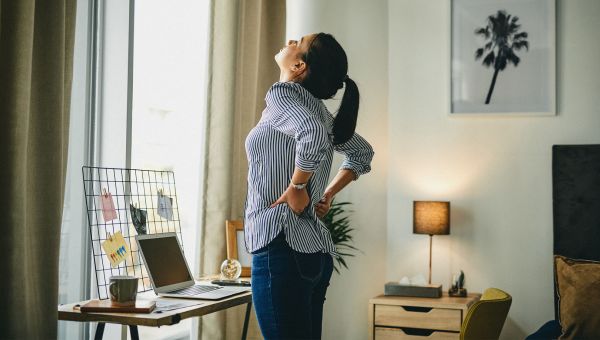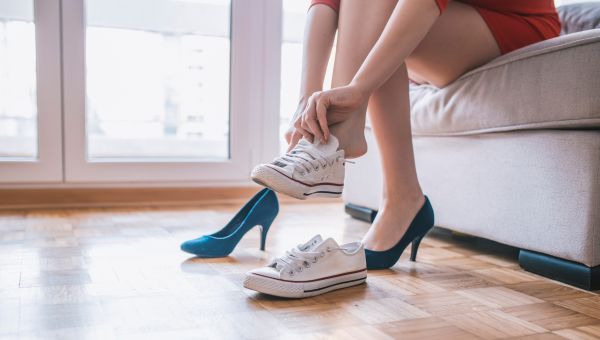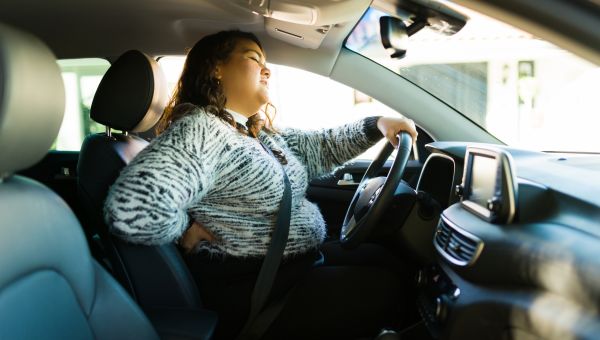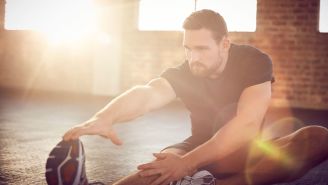5 surprising habits that cause back pain
These seemingly harmless habits can leave your back screaming for mercy.

About eight out of 10 Americans experience back pain at some point in their lives. In fact, back pain is the most common type of chronic pain. But often the cause can be a mystery, especially if you’re not moving heavy objects all day. It turns out some common habits may be wreaking havoc on your back. Read on for five surprising sources.

You're Glued to Your Phone
Think about how often you're looking at your phone. Americans use their phones while they’re walking down the street, in their cars, for work and exercise, even at the dinner table. Using your phone constantly can result in poor posture, which can lead to back pain, says Ryan Church, DNP at MountainStar Comprehensive Spine Centers and St. Mark’s Hospital in Salt Lake City, Utah. “The best way to hold your phone is a neutral spine with your phone directly in front of your eyes,” he says. Looking down at your phone brings your head forward past your shoulders, which puts stress on the spine, also known as “tech neck.”

You Wear the Wrong Shoes
Those high heels may be part of your favorite outfit, but they could be doing a number on your back. High heels pitch you forward, putting increased weight-bearing on your toes. To compensate, you make change your gait, stride length or walking speed, as well as use different muscles than you may be used to when walking. All of this may put stress on the lower back. Wearing heels occasionally is probably ok, says Church, but if you wear them frequently, you could be asking for back trouble. “As the number of hours women spend in shoes like that increases, it throws off body mechanics and gait,” says Church.

You Lug a Heavy Purse or Backpack
Look inside your purse. Do you really need more makeup than a Sephora store and that book you haven’t gotten around to reading? Heavy purses and backpacks can cause back pain, especially if you’re carrying them inefficiently. “The proper way to carry anything is close to the core,” says Church. “With a backpack, use both straps and make sure they’re well-fitting. Keep the weight low to the waistline.” Ditto for the purse, he says, minus the two straps, of course.
Backpacks should be no more than 10 percent of your body's weight. Your backpack or purse may be too heavy if you are in pain while wearing it, have difficulty putting it on or removing it, feel numbness in your limbs, have marks on your shoulders from the straps or notice your posture changing.

You Smoke
As if you needed another reason to quit smoking—lighting up can exacerbate or even cause back pain, according to some research. Church believes it’s because smoking creates an oxygen deficiency in the body. “Small nerve endings in an oxygen-poor environment become hyperactive and send more pain signals to the brain. Secondly, tissues break down faster due to poor circulation, particularly in the spine,” he says. The solution is simple, but not easy: quit smoking. A 2016 study of more than 34,000 Americans found that back pain was more prevalent in current and former smokers than in people who have never smoked.

You Drive with Poor Posture
Sitting in a car puts pressure on your intervertebral discs, and the discs take the brunt of the vibrations created when driving, says Church. A 2015 study conducted by the AAA found that the average person drives 46 minutes per day, which really adds up over the course of a year. If you spend all that time in a car, make sure you’re driving with good posture: knees level with your hips or slightly higher, natural arch to your spine (no slumping), and consider using a pillow to support your lower back. Your head should be pointed straight ahead and mirrors set up so you don’t have to move your head too much to see them, says Church. Adjust your seat closer or further away from the steering wheel to get the right posture.

UpToDate. Evaluation of low back pain in adults. December 2020.
Mills SEE, Nicolson KP, Smith BH. Chronic pain: a review of its epidemiology and associated factors in population-based studies. Br J Anaesth. 2019;123(2):e273-e283.
Pew Research Center. Mobile Fact Sheet. June 12, 2019.
Jung SI, Lee NK, Kang KW, Kim K, Lee DY. The effect of smartphone usage time on posture and respiratory function. J Phys Ther Sci. 2016;28(1):186-189.
Schroeder J, Hollander K. Effects of high-heeled footwear on static and dynamic pelvis position and lumbar lordosis in experienced younger and middle-aged women. Gait & Posture. Volume 59. January 2018.
Afzal F., Manzoor, S. Prolong Wearing of High Heeled Shoes Can Cause Low Back Pain. J Nov Physiother 2017, 7:4
Zhang, Ting-Ting MB; Liu, Zhen MB; Liu, Ying-Li MD; Zhao, Jing-Jing MM; Liu, Dian-Wu MD; Tian, Qing-Bao MD. Obesity as a Risk Factor for Low Back Pain, Clinical Spine Surgery. February 2018. Volume 31. Issue 1.
University of Iowa Hospitals and Clinics. Is your backpack too heavy? July 2020.
Shi Y, Weingarten T, Mantilla C, Hooten WM, Warner, D. Smoking and Pain: Pathophysiology and Clinical Implications. Anesthesiology. 2010; 113:977–992
Green BN, Johnson CD, Snodgrass J, Smith M, Dunn AS. Association Between Smoking and Back Pain in a Cross-Section of Adult Americans. Cureus. 2016 Sep 26;8(9):e806.
Cleveland Clinic. Is Your Driving Posture Causing You Pain? June 26, 2019.
Andrew Gross. New Study Reveals When, Where and How Much Motorists Drive. AAA. April 16, 2015.
More On


video

article

slideshow


video


video
